Answers to Frequently Asked Questions
|
1) Modular and non-modular origami -- what's the difference?
In traditional origami, an object is created by folding a single sheet of paper. This approach is also called non-modular origami. A well-known example of non-modular
origami is the Traditional Japanese Crane, shown at right.
In modular origami (also called unit origami), an object is created by assembling two or more modules (or units). The multiple units are then joined together cleverly
without tape or glue, usually by inserting a tab-like part of one unit into a pocket-like part of another.
All of the kusudama and wreaths featured on this site, and most of the other items, are modular. However, you will also find a few non-modular items, such as chopstick
wrappers and bird ornaments.
A modular project may entail a large number of units or only a few. For example, most of the kusudama featured on this site were assembled from 30 units. However,
some kusudama required only 12, 18, or 24 units.
|
|
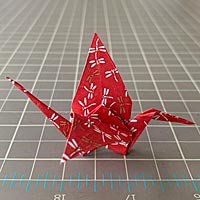
Non-Modular: Traditional Crane |
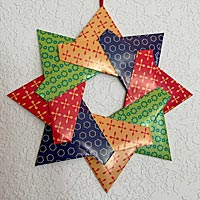
Modular: 8-Unit Star
| |
Most of the wreaths featured on this site required between 8 and 18 units. The modular stars required between 4 and 16 units.
The modular approach to origami greatly expands the creative possibilities of this hobby,
since several different types of paper can be combined in one item. Basic units can be tweaked slightly to produce new styles, or they can be assembled in a different manner to
produce new shapes.
The eight-pointed Robin Star shown at left, which was designed by Maria Sinayskaya, is a good example of how paper sheets with different colors and patterns can be combined when using the
modular approach.
For an example of how the same basic unit can be used to make different shapes, compare these two hanging ornaments:
the Triangle Edge Tetrahedron
and the Triangle Edge Octahedron. Both are assembled from the Triangle Edge Module, designed by Lewis Simon and Bennett Arnstein.
|
Back to Top
2) What is a Kusudama?
|
A literal translation of the Japanese word kusudama is "medicine ball." In ancient Japanese culture, kusudama contained herbs or other plants thought to have
health-giving properties. They might also be filled with incense or potpourri. In more recent times, kusudama have become very popular as holiday decorations and gifts.
Sometimes you may see kusudama referred to as flower balls, floral globes, or decorative polyhedra. By any name, they are beautiful to look at, fascinating to
study, and challenging to construct.
Kusudama are made by folding multiple sheets of paper into stylized flowers or other attractive components (units) and then joining those
together in some manner to create a three-dimensional model.
|

Sewn Together Kusudama |
|
The older, traditional way of assembling a kusudama is still practiced by many crafters today. It involves sewing the units together so that they form a
spherical shape -- often with a tassel hanging from the bottom. Some crafters prefer to use glue instead of sewing.
An example of a sewn-together kusudama is the
Aurora Kusudama shown at left, made from a kit.
A more modern approach to creating kusudama involves using modular origami techniques for joining the units together without sewing or glue.
An example is shown at right. Designed by Ekaterina Lukasheva, this lovely kusudama is called Passiflora Delicata.
It was assembled from 30 units, with each unit having a tab-like part
and a pocket-like part. The finished structure resulted from inserting tabs into pockets according to a specific plan.
|
|

Modular 30-Unit Kusudama |
|
A few of the kusudama shown on this site have been sewn together, but most were made using modular origami techniques. Occasionally, a little glue has been used to
strengthen an otherwise fragile kusudama, but the vast majority were made without any glue, tape, or other adhesives.
|
Back to Top
3) What is a Sonobe?
|
In the 1960's, Mitsunobu Sonobe created a design for an origami unit which could be connected with other units of the same type in order to assemble a variety of three-dimensional shapes.
His new unit became known as a Sonobe Unit and shapes constructed with it were often called Sonobes.
Since then, many other origami designers have created variations on the basic Sonobe Unit and its use has become widespread in the origami world.
Maria Sinayskaya's
Imperial Rose Sonobe,
shown at right, is a good example of how the simple Sonobe unit can be tweaked to produce an elaborate ornament.
This web site includes many 12-unit and 30-unit Sonobes. They have been grouped together with other
types of floral globes and decorative polyhedra, all under the general title of Kusudama.
|
|
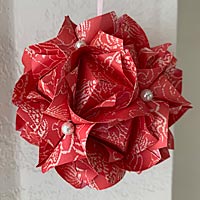
30-Unit Sonobe |
Back to Top
4) What is a face-and-base unit?
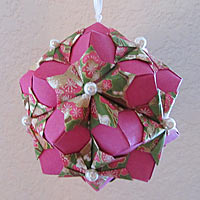
Face-and-Base Kusudama |
|
Sometimes each module (unit) for a kusudama is made by combining two components: a face and a base.
One small sheet of paper is folded to create a base and another sheet is folded to create a face. After the face is inserted into the base, there may be additional folds required to complete the unit.
This technique allows for the use of two different types of paper in each unit, greatly expanding the variety of patterns and color combinations which
can be achieved in the finished model.
The 30-unit Chrysanthemums kusudama at left, designed by Tomoko Fuse, is a good example.
The face component of each unit was made from Yuzen Chiyogami Washi with a traditional pattern, while the base component was made from solid color craft paper.
Tomoko Fuse has designed a huge variety of beautiful kusudama using the face-and-base approach. This site features 20+ different Fuse models of that type.
|
Back to Top
|
5) What is an origami polyhedron?
In geometry, a polyhedron (plural = polyhedra)
is a three-dimensional shape with flat polygonal faces, straight edges, and sharp corners or vertices. Polygonal faces include
faces shaped like triangles, squares, pentagons, hexagons, and octagons.
The most familiar of all the polyhedra is the simple cube with its six square faces. Other polyhedra are more complex and less familiar: the tetrahedron, octahedron, cuboctadedron, icosahedron, and
dodecahedron. Some polyhedra are extremely complex and even less familiar: the icosidodecahedron, rhombicuboctahedron, and rhombicosidodecahredron.
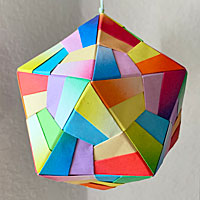
Origami Polyhedron: Icosahedron
| |
Modern origami masters have created hundreds of different designs for turning flat sheets of paper into all of these three-dimensional shapes. The beautiful 30-unit
Patterned Icosahedron shown at left, designed by Meenakshi Mukerji, is a good example.
Most of the kusudama and sonobe models featured on this web site were assembled with icosahedral symmetry, but you will also find quite a few models where the underlying geometry is different.
Appreciating the beauty of an origami polyhedron does not require a deep understanding of geometry. However, knowing a bit more about geometry will lead to a
greater appreciation of the origami designer's ingenuity and the folder's skill/patience.
Use this link to learn more: https://en.wikipedia.org/wiki/Polyhedron*
|

|
Back to Top
6) Who designed the kusudama, wreaths, ornaments, and accessories shown on this site?
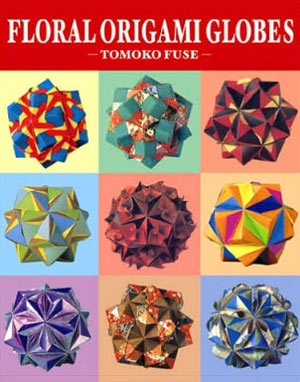
"Floral Origami Globes" by Tomoko Fuse |
|
Clicking on the image for any origami item featured on this site will provide you with many details about that item, including the name of the individual who originally designed the
origami model. In most cases, you will also see information about where Teresa found the design -- a book or kit, a PDF on the web, or a video on the web.
Most of the kusudama shown on this site were designed by Tomoko Fuse, Maria Sinayskaya, Meenakshi Mukerji, Ekaterina Lukasheva, and Masha Athanasiadi. Diagrams and instructions
can be found in these books/kits:
- Floral Origami Globes by Tomoko Fuse (Japan Publications Trading Co., Ltd., 2017)
- Zen Origami: 20 Modular Forms for Meditation and Calm by Maria Sinayskaya (Race Point Publishing, 2016) - kit including paper
- Ornamental Origami: Exploring 3D Geometric Designs by Meenakshi Mukerji (A K Peters, Ltd., 2009)
- Exquisite Modular Origami by Meenakshi Mukerji (CreateSpace Independent Publishing Platform, 2011)
- Kusudama Origami by Ekaterina Lukasheva (Dover Publications, Inc., 2014)
- Floral Origami by Ekaterina Lukasheva (New Origami Publishing, 2018)
- Kusudama Bouquet: Book 1 by Masha Athanasiadi (Smartframes Audiovisuals Limited, 2018)
- Kusudama Bouquet: Book 4 by Masha Athanasiadi (Smartframes Audiovisuals Limited, 2018)
For a complete list of all the books, kits, and magazines referenced on this site -- along with how to find them on the web, and examples of the models found in each -- use the links here:
|
Books | Kits | Magazines
|
|
Some of the kusudama on this site were made from designs by Bennett Arnstein and Rona Gurkewitz, Krystyna Burczyk, Enrica Dray, El*ke, Faye E. Goldman, Kankichi, Miyuki Kawamura, Toshikazu Kawasaki, Isa Klein, Silvana Betti Mamino, Valentina Minayeva, David Mitchell, Yoshihide Momotani, Nobuko Okabe, Christine Pape and Till Dursch, Anzhelika Pas'ko, Lew Rozelle, Katrin and Yuri Shumakov, Sansanee Termtanasombat (PrwOrigami), Herman Van Goubergen, and David Martinez Venezolano.
|
Most of the wreaths, rings, and stars shown on this site were designed by Paolo Bascetta, Mark Bolitho, Francesco Guarnieri, Hans-Werner Guth, Isa Klein, Jose Meeusen, Minakshi Mukerji, Mimi Nohara, Nobuko Okabe, Mari Ono, Francis Ow, Mette Pedersen, David Petty, Wuri Dyah Putranti, Darren Scott, Camila Silveira, Lewis Simon, Maria Sinayskaya, Sok Song, Carmen Sprung, Sweetpaper, and Evan Zodl.
The chopstick wrappers shown on this site were designed by Tomoko Fuse.
Other ornaments, wall hangings, and accessories were designed by Simon Andersen, El*ke, Robert Foord, Ilan Garibi, Francesco Guarnieri, Minako Ishibashi, Paul Jackson, Michael G. LaFosse, Tung Ken Lam, Marcia Joy Miller, Jeannine Mosely, Francis Ow, Joe Power, Nick Robinson, Fumiaki Shingu, Mitsunobu Sonobe, Toshie Takahama, and Makoto Yamaguchi.
Back to Top
7) Why are there no origami diagrams/instructions on this site? Where can I find some?
Most of the items shown on this site were made by following diagrams/instructions from copyrighted books or materials. Without permission from the copyright holder, these diagrams/instructions
can not be published here. In the future, it may be possible to get the needed permission -- at least for some of
the origami models.
Meanwhile, this site provides many links to many other web sites which offer diagrams and/or video tutorials for making kusudama and other origami ornaments and accessories.
Click on the image of any item displayed on this site to access more details about that particular item. In many cases, those details will include useful links to other web sites.
We have recently gathered up the many model-specific links scattered around this site and organized them all in one place for your convenience, with a special search
form to help you find exactly the type of links you want for a specific category of origami models.
Please try out this new Model-Specific Links Page*
Also new to this site is our General Links Page*
There you will find links to numerous web sites offering free origami diagrams and/or video tutorials --
along with links to origami societies and databases, web sites or blogs of individual origami designers, articles about the history of origami, reviews of different types of paper,
and online origami shops.
All of these links are provided as a convenience and for informational purposes only. They do not constitute Teresa's endorsement or warranty of any products
or services offered by other corporations, organizations, or individuals. Teresa does not benefit financially from providing these links. (For more details, see
our External Links Disclaimer)
Back to Top
8) Who folded and assembled the origami items shown on this site?
All of the origami items on this site were hand-folded and assembled by Teresa Ritter.
After a 25+ year career as a Human Resource Management professional, followed by 10 years as a self-employed web site designer
and developer, Teresa is now enjoying her retirement and the leisure time it gives her for pursuing various hobbies.
Making origami decorations and accessories is a very rewarding activity for her.
Deciding how to combine different colors, patterns, and textures of
paper provides a stimulating creative challenge, while the actual folding induces a Zen-like sense of calm.
Teresa hopes that you will enjoy viewing the items on this site as much as she enjoyed making them.
Back to Top
9) What types of paper went into making these items? Where did the paper come from?
|
By clicking on the image of any item displayed on this site, you can access detailed information about the type of paper used to make that particular item. In most cases,
you will also find a link to an online source for that paper. (Note our External Links Disclaimer)
Kami and Duo Kami, Japanese washi (kozo) and momigami, foil, TANT, rice paper, Nepalese lokta and other mulberry papers, craft paper, letterpress paper, scrapbooking paper, gift wrap, money, old calendars -- Teresa has folded them all!
Double-sided paper has almost always
been used for those origami models which reveal both sides of the paper.
The quality of the paper used ranges from inexpensive machine-made origami paper, purchased in value packs from craft stores, to expensive sheets of silk-screened Yuzen Chiyogami Washi, imported from Japan and
ordered online from specialty paper sellers.
For an excellent but quick guide to different types of origami paper, visit: https://origami.me/paper/*
For more links to articles/guides about paper, click here
|
|
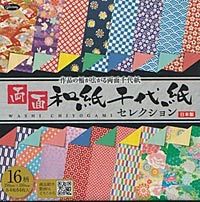
Double-Sided Chiyogami Pack |
Back to Top
10) What sizes and shapes of paper went into making the items on this site?
By clicking on the image for any item displayed on this site, you can access detailed information about the number, shape, and size of the sheets used to make that particular item. You will
also see the overall size of the finished item.
Various types of origami paper are sold in square sheets of the following sizes: 21 cm (about 8 1/4 in), 15.2 cm (6 in), 15 cm (about 5 7/8 in), 11.75 cm (about 4 5/8 in), 10 cm (about 4 in), and 7.5 cm (about 3 in).
Teresa has used all of these sizes at one time or another.
Some origami paper is sold in round sheets or in thin strips. Certain types of curler balls require round sheets and
the strips are used to make lucky stars.
Many of the origami models featured on this site require small rectangular sheets which can be obtained by cutting up square sheets. For example, most of Tomoko Fuse's kusudama
designs were made from 5 cm by 10 cm (about 2 in by 4 in) rectangles. Four of those rectangles can be cut from a 15 cm square.
A few of the models shown on this site require sheets shaped like pentagons or hexagons, which can be cut from squares.
For information about where to shop online for origami paper, click here.
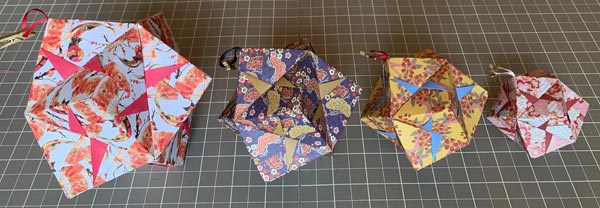
Same Model Made With Four Different Sizes of Paper |
|
Often an origami designer will recommend a specific sheet size in his or her instructions, but it may be possible to use smaller or larger
sheets of paper, thus changing the dimensions of the finished model, as shown in the image at left.
The sheet sizes used here, moving left to right, were: 15.2 cm (6 in), 12 cm (about 4 3/4 in), 10 cm (about 4 in), and 7.6 cm (3 in).
Experimenting with different sheet sizes can be fun. However, when a rectangular sheet is required, be careful to maintain the specified height-width ratio.
For example, if a 6 cm by 12 cm rectangle is specified, the ratio is 1:2. You could safely use a 5 cm by 10 cm sheet or a 7.5 cm by 15 cm sheet.
|
Special Note on Large vs. Small Sheets for Kusudama
Working with small sheets is challening, so many people like to practice a new model with large sheets first, and then try it again with small sheets
after they have become comfortable with the model. This works well for many types of origami, but not for kusudama.
Creating a 30-unit kusudama with large units may actually be more difficult than creating it with smaller units.
Large units can be unwieldy during the assembly process. They flop around and tend to come apart readily. Smaller units usually fit together more snugly.
Also, using smaller units makes it easier to see how the three-dimensional geometric shape of the finished model is gradually developing during the assembly process.
Back to Top
11) What did Teresa do with all these kusudama, ornaments, and accesssories? Where did they end up?
Some of the items shown on this site were given to Teresa's relatives and friends as gifts. Some are still being used in her home, especially at the holidays.
The vast majority of Teresa's kusudama, ornaments, and accessories were given away at small craft fairs to raise funds for non-profit organizations. Some of the groups to which Teresa has
donated her fundraiser proceeds include:
- Valerie's House (FL - youth grief counseling center)
- ChildFund Internationa (India and Brazil)
- Peace River Wildlife Center (FL)
- Gulf Cove United Methodist Church (FL - for hurricane damage repairs)
- Florida Disaster Fund
- Punta Gorda Garden Club (FL -- for scholarships)
- All Hands and Hearts (FL - for victims of Hurricane Michael)
- Rebuild 850 (FL - post-hurricane assistance)
- Fund for Victims and Families (Marjorie Stoneman Douglas High School shooting, Parkland, FL)
- Sebring Strong Survivors' Fund (SunTrust Bank shooting, Sebring, FL)
- Peace River K-9 Search and Rescue (FL)
- Support Surfside (FL - for victims of tower collapse)
If you would like to learn more about "folding for funds", click here.
Back to Top
|
|
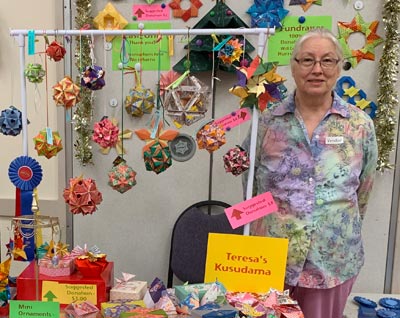 |
12) Does Teresa make any origami models other than kusudama, ornaments, and accessories?
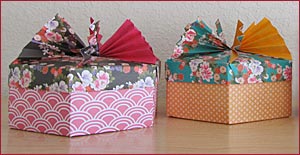 |
|
Teresa enjoys using her skills to fold and assemble many different types of origami models.
She especially likes to make boxes, bowls, and other
containers -- both modular and non-modular --
in every size, shape, color, and design imaginable. To share this aspect of her origami hobby, Teresa has created a web site which currently features over 1,700 items!
Click here to see Teresa's origami boxes, bowls, and other containers
|
Back to Top
13) Has Teresa ever won any awards for her origami?
Teresa frequently exhibits her origami items at the Charlotte County Fair in Florida. She has earned numerous Blue Ribbons, as well as a Best in Show Ribbon.
Click here for more details about awards
Back to Top
|
|
![[Awards for Kusudama] [Awards for Kusudama]](/AwardImgs/2018awards.jpg) |
|
![[Award for Origami Wreath] [Awards for Origami Wreath]](/AwardImgs/2020Mette.jpg) |
14) Does Teresa ever teach any origami classes?
Teresa teaches both a beginner-level origami class and an intermediate-level origami class at the North Port Public Library in North Port, FL.
Click here to learn more*
|
Back to Top
|